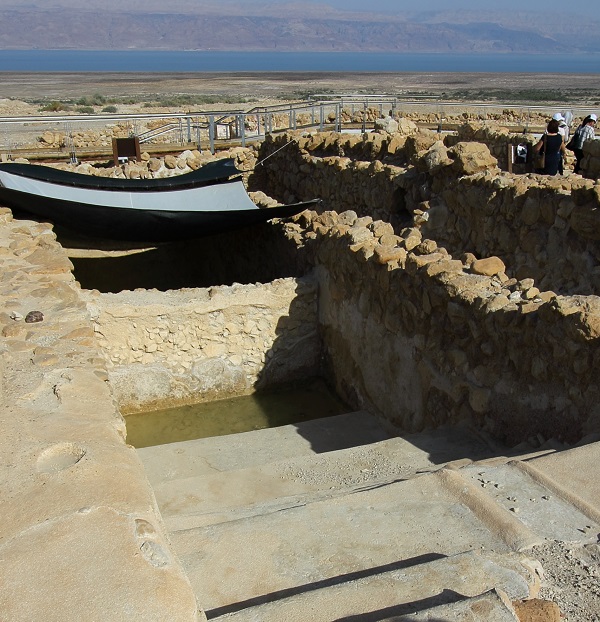Where did baptism come from? (Matthew 3:6)

Why did Jewish people come out to John to be “baptized by him in the river Jordan, confessing their sins” (3:6)? There’s nothing about baptism in the Old Testament. Sure, John would have been a curiosity: there were few prophets in living memory. But why did people take the plunge with John?
Ritual washing was already part of the Jewish faith. Priests were consecrated for their duties via a ritual washing (Exodus 29:4; 40:12). A bronze washbasin stood in the tabernacle courtyard because the priests were to wash every time they entered the sanctuary or offered a sacrifice (Exodus 30:18-21). The entrails and legs of sacrifice animals also needed ritual washing (Exodus 29:17; Leviticus 1:8-13). In the temple, a large cast bronze sea supplied the water needed for these ablutions (1 Kings 7:15–24).
In fact, anything unclean needed purification. Often that meant ritually washing the person and their clothes. This applied to Levites (Numbers 8:7, 21), priests (Numbers 19:7), and people in general (Leviticus 14:8-9).
Washings were required for whatever made a person or thing unclean: spreading skin diseases (Leviticus 13:6, 34), encroaching mould (Leviticus 13:53-58), bodily discharges (Leviticus 15; 22:6), touching something dead (Leviticus 11:25, 28), …
It was really important for soldiers to remain ritually pure to fight a holy war. Like the priests, the soldiers were called to consecrate themselves (Joshua 3:5; 7:13). If they touched dead bodies, they needed purification again (Numbers 31:19-24). Soldiers on duty were to avoid sexual contact; even if a soldier ejaculated in his sleep, he needed to be purified (Deuteronomy 23:9–11). David was depicted as an impure leader when he took the wife of one of this soldiers. Bathsheba was doing the right thing — purifying herself after her period (2 Samuel 11:4). Uriah did the right thing — remaining ready for active duty by sleeping outside when David brought him home (11:11). But David betrayed his people, taking Uriah’s wife and then his life.
Soldiers didn’t want YHWH fighting against them, as happened at Peor when plague broke out among them (Joshua 11:17). You can understand their extreme interest in ritual washing if it could keep them from death. Priests who failed to wash were threatened with death (Exodus 30:20-21), so you can understand how ritual washing became almost a talisman for soldiers preoccupied with staying alive.
It is hardly surprising, therefore, that archaeologists find ritual baths (miqvot) in the places where zealot guerrillas hung out — both in Galilee (e.g. caves above Migdol) and in Judea (e.g. atop the Herodium). Ritual washings were part of life for rebel forces.
The Qumran community also had its miqveh. According to the War Scroll, they anticipated a messiah-figure who would lead them to victory over their enemies (1Q33 Col. xiv:2-4). But for Qumran, purification wasn’t just about war. They saw themselves as replacing the corrupt and defiled priesthood in Jerusalem. Since they felt they were the true priests, they observed the priestly purification rituals. Ritual washings were part of life at Qumran.
And that’s probably the best way to think about the ritual cleansing John offered. John’s baptism had its roots in the ritual washings legislated in the Torah. Yet, it was more than simple purification rites. Over time, physical washing came to signify inner cleansing too. For example, the Psalms place these words in the mouth of the unclean King David:
Psalm 51:2, 7 (ESV)
2 Wash me thoroughly from my iniquity, and cleanse me from my sin! …
7 Purge me with hyssop, and I shall be clean; wash me, and I shall be whiter than snow.
So what can we say about John’s baptism? John is announcing the return of YHWH as sovereign over his people—the restoration of heaven’s reign. John called God’s people to repent, to stop resisting their king. The sins of God’s people had kept them in captivity to other rulers for far too long. The time had arrived for their liberator to release them (1:21). The anointed ruler would chop down the fruitless branches (3:7-10), cleansing his people with the Holy Spirit and fire (3:11-12). John’s baptism prophetically enacted with water the cleansing that the Messiah was about to bring to Israel.
Previous prophets had a similar message:
Isaiah 1:16 (ESV)
16 Wash yourselves; make yourselves clean; remove the evil of your deeds from before my eyes; cease to do evil.
What John did was to combine two things in a new way: the message of the prophets, and the cleansing rituals of the priests. Everything from the Law and the Prophets was about to come together in the one he was about to reveal—the anointed ruler who would cleanse God’s people and restore God’s reign.
It does all come together in him. Jesus submits to the purification ritual on behalf of his people, and is instantly proclaimed to be the heaven-sent king (3:13-17).
What others are saying
David L. Turner, Matthew, Baker Exegetical Commentary on the New Testament (Grand Rapids, MI: Baker Academic, 2008), 110:
John’s baptism should be understood in connection with biblical ritual cleansings, Jewish proselyte baptism, and the cleansing rituals of the Qumran community (see Badia 1980; Gnilka 1961–62; Pusey 1984: 141–45; D. Smith 1982; J. Taylor 1997: 49–100). It seems best to view it against a broad background of similar acts rather than attempt an explanation that draws from only one of the possible backgrounds. The Hebrew Bible itself frequently alludes to water cleansing as a picture of forgiveness, spiritual purity, and eschatological blessing (Ps. 51:6–9; Isa. 4:4; 44:3; Jer. 4:11–14; Ezek. 36:24–27; Zech. 13:1). But there are three important contrasts between John’s baptism and these possible backgrounds. First, John insists on repentance and baptism for Jews, not gentile proselytes. This would have countered the current view that Israel’s problems were due only to gentile oppression and that the Messiah’s mission was merely to set Israel free from this oppression. Descent from Abraham was no guarantee of God’s favor (3:9). Second, John’s baptism was a single act of confession, not a repeated ritual as in the Hebrew Bible and in the Qumran community. Third, John’s ministry and baptism were directed toward the nation of Israel as a whole, not toward a sectarian monastic community as at Qumran. W. Davies and Allison (1988: 299) may be correct that John’s baptism was a creative reapplication of biblical and cultural motifs in keeping with his prophetic insight into God’s will.
The War Scroll (1Q33 Column 14 Rows 2-4) imagines the cleansing of the soldiers after their victory like this:
2After they have withdrawn from the slain to return to the camp, all of them shall sing the hymn of return. In the morning they shall wash their clothes, cleanse themselves 3of the blood of the sinful bodies, and return to the place where they had stood, where they had formed the battle line before the slain of the enemy fell. There they shall all bless 4the God of Israel and joyously exalt His name together.
[previous: A voice in the wild]
[next: A king announced by a prophet]
Seeking to understand Jesus in the terms he chose to describe himself: son of man (his identity), and kingdom of God (his mission). Riverview College Dean
View all posts by Allen Browne






